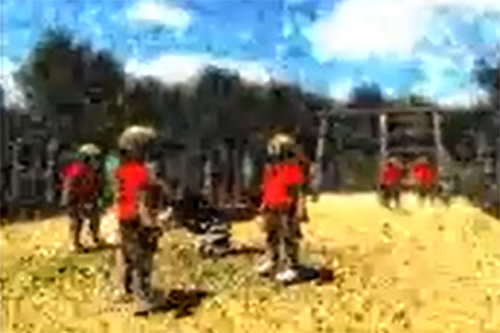Last winter, three developers at a weekend hackathon in Vancouver presented their first-person videogame “Auti-sim,” designed to simulate the experience of sensory overload as it’s experienced by an autistic child. In their one-minute prototype (below), the player’s point of view lurches around a playground. The visual field is filled with undifferentiated faces and unfocused images; the colors are supersaturated and the pixilation is unstable. Turn off the sound and the effect is somewhat like trying to balance on one foot while standing too close to a pointillist painting. Add the soundtrack—a cacophony of children’s voices—and the experience becomes deeply unsettling.
Team leader Taylan Kay (his given name is Taylan Kadayifcioglu) told a reporter at Ars Technica that his wife does group therapy with families with special-needs children. He hoped the game might help siblings of autistic children understand what their brothers and sisters are going through.
Kay’s efforts were inspired by Inside Autism, an hour-long documentary written and directed by a high-functioning autistic (her diagnosis is Pervasive Developmental Disorder Not Otherwise Specified, or PDD-NOS) who identifies herself as Cyndi H.

Cyndi H. attempts to convey the experience of autism to “neurotypicals” through her camera, whose jerking movements convey distractibility, and soundtrack, which is remixed and intensified to demonstrate, for example, how painful the high-pitched overtones of a vacuum cleaner can be. In the course of a harrowing trip to Walmart, the sound of the clanking shopping carts becomes almost unbearable. Her narration is poignant. It begins fairly late in the movie with an account of how challenging spoken language is for her.
“So much has to happen when you speak,” she explains. “It’s not just your vocal cords and your mouth. First you have to think of the word. Secondly, you have to think, ‘How do you pronounce the word?’ Third, you’ve got to enunciate properly so people can understand you. Fourth, you have to modulate your voice to the proper volume; you can’t be too loud or too quiet. And five, you’ve got to actually talk and make a sentence. So you’ve got to do those five steps over and over again. A lot of people may not even think of that, they just talk and it’s simple. But I am conscious of all those steps, even now, with every word I’m saying.
“I have the most perfect analogy for social situations from the perspective of somebody with autism, like me,” she continues. “Imagine you go to a play. It’s a brand-new play—no one has seen it or heard it except for the actors who are in it. So you’re in the front row. And all of a sudden, someone runs out of the stage and jumps down and grabs you and says, ‘Here, come on, we need you for the lead role,’ and they pull you in and all of a sudden you’re out on the stage and everybody’s looking at you, everybody’s staring. You don’t know what the story is about, you don’t know what your role is, you don’t know any of the cues, you don’t know what you’re going to say, you don’t know anything, you’re just, all of a sudden you’re there. And everybody’s looking at you expectantly. That is a social situation for an autistic person.”
Cyndi H.’s task is much more ambitious than that of Taylan Kay and his colleagues, who merely attempted to reflect one transient feature of an autistic person’s experience. “I wasn’t really aiming to simulate what hypersensitivity actually is,” Kay says. “My goal was to elicit the same kind of reaction from a neurotypical person. So the goal was basically to irritate the hell out of your senses.” Auti-sim is basically a special effect, a piece of showmanship. It does, in a sense, what Sid Caesar used to do in one of his comedy shticks on TV, when he mimicked the sounds of foreign languages in gibberish.
With the help of an interpreter like Cyndi H., I can get glimmers of the radically different way that a person on the autism spectrum experiences the world, but no mere “simulator” can do their perspective justice. It’s like seeing an ad on your regular TV for an HD TV.
But if Cyndi H. gives the lie to the notion that to be on the autism spectrum is to be deficient in empathy, at some point the gap between not just autistics and neurotypicals but between any human being and another becomes unbridgeable. When you and I have a conversation about the color red, how do we know that we are both seeing the same things? We are using the same vocabulary, yes, but what if what looks like “blue” to me looks like “red” to you? As long as we use the same words consistently, we’ll never really know.
In The Mind’s Eye, the neurologist Oliver Sacks wrote about people with visual dysfunctions, including himself. Cancer treatments deprived Sacks of the vision in his left eye; his description of the trauma he endured while adjusting to life without binocular vision made me realize that I had the same handicap myself, a self-diagnosis that my ophthalmologist then confirmed. Now I know why the 3-D version of Avatar left me feeling underwhelmed. But I could never convey my experience of life in a flattened-out world because I’ve never experienced a rounder one.
With the help of an interpreter like Cyndi H., I can get glimmers of the radically different way that a person on the autism spectrum experiences the world, but no mere “simulator” can do their perspective justice. It’s like seeing an ad on your regular TV for an HD TV. “The picture you see,” the narrator says, “is unbelievably clear.” But of course the picture they’re showing can only be as sharp as your own TV can render it.
Post Disclaimer
This content is for informational purposes only and does not constitute medical advice. Please consult a healthcare professional for any medical concerns.



